Modak is Bhagwan Ganesha’s favorite sweet and made in many Hindu homes during the first day of Ganesh Chaturthi Festival. The most popular variety of modak that is made is Ukadiche Modak (steamed modak) which is from the Maharashtrian Cuisine. In this post I am sharing two ways of making modak recipe – with mould and without the mould.
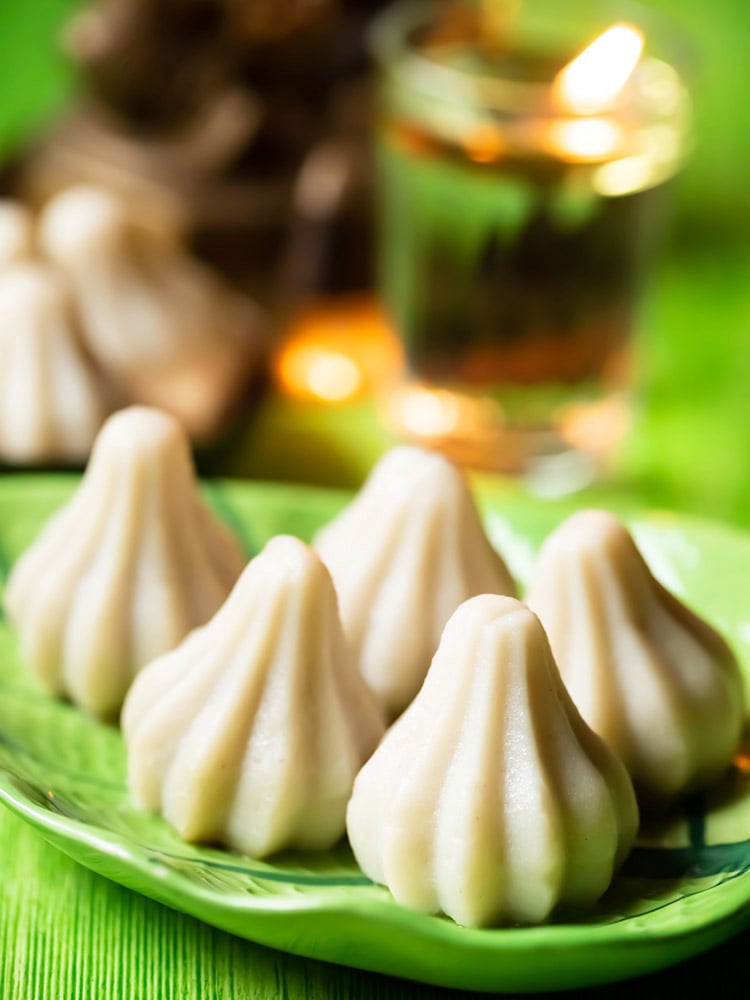
Table of Contents
What is Modak
Modak are steamed dumplings with an outer rice flour dough and a coconut-jaggery stuffing. These sweet dumplings are also known as Ukadiche Modak in Marathi language.
The word ukadiche means ‘that which is steamed’ or ‘steamed’. The word ‘ukad’ also means steamed rice flour dough. So in simple English “Ukadiche Modak” means steamed modak.
The South Indian variation of Ukadiche Modak is called Kozhukattai or Kolukattai which is made during Vinayaka Chaturthi in the Southern Indian states of Kerala and Tamil Nadu.
How is Ukadiche Modak made
For the Ukadiche Modak, the coconut-jaggery stuffing and rice dough are made initially. Then, portions of the rice dough are shaped in a ball, flattened and filled with the stuffing.
The edges of the flattened rice dough is then pleated, folded and shaped to make a beautiful fluted dumpling what we call as Modak. After shaping the Modak is then steamed.
Modak can be shaped in many ways. You can make them with the fluted petal shape or even in the shape of half-moon similar to Karanji and Gujiya.
To give the fluted shape with hands some practice and experience is required. I prefer to use modak moulds as I find shaping with them is quicker than shaping with hands.
Many shops begin to sell the modak moulds before Ganesh Chaturthi festival. You can even buy them online. If you are beginners then you can make the half-moon shape for modak or buy the moulds.
Making modak recipe does take quite some time and can be a messy affair, especially if you don’t get the texture of the rice dough right.
By practice, you will learn to make better modak at home. Preparing modak recipe does require patience and effort. It is good if you have the modak moulds. They make the stuffing work easier.
There is another variant of modak recipe where the outer crust is made from whole wheat flour and fried – called Fried Modak. Also these Rava Modak also do not require any steaming.
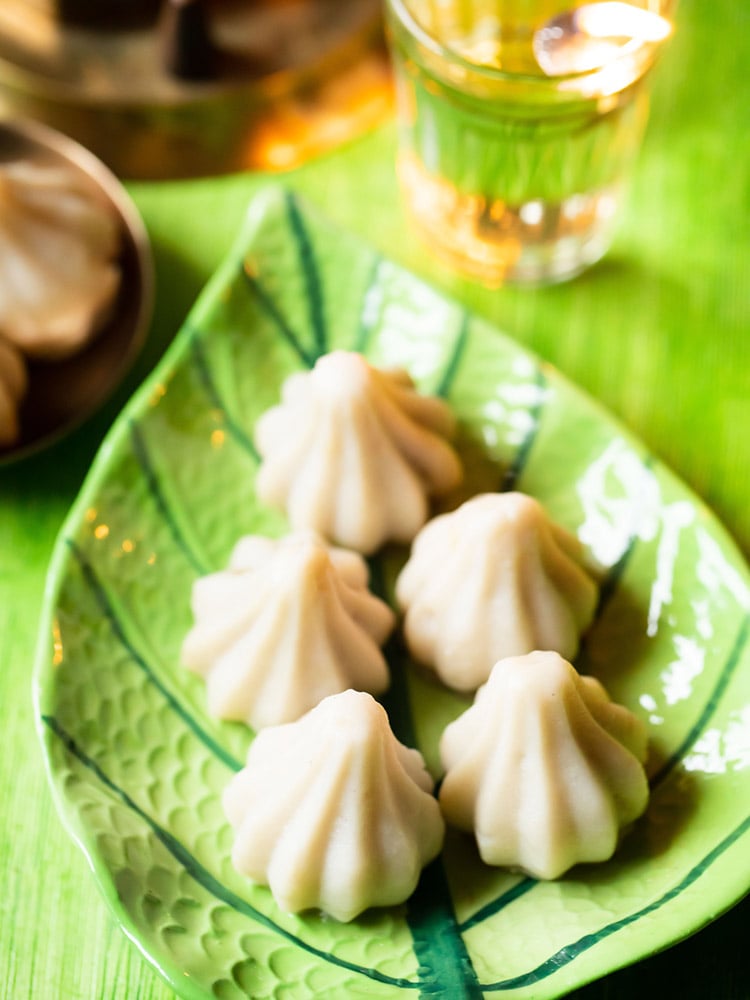
On Ganesh Chaturthi Festival
This year Ganesh Chaturthi is starting on August 31, 2022 and as usual will last for 10 days.
A happy Ganesh Chaturthi to all the readers, in advance. I pray that Bhagwan Ganesha bestows prosperity, luck and blessings to everyone. If you are looking for recipes which are made during Ganesha festival then you can check this list of Ganesh Chaturthi Recipes.
The Ganesh Chaturthi festival is one festival I have grown up with. I would see as a kid how we, the devotees of Bhagwan Ganesha would bring him and worship him with so much love and prayerfulness in our hearts and homes.

This aspect of devotion and gratitude became a part of me and is something which I still have. I can never forget those days when I would simply wait for Ganesh Chaturthi festival and would not like when we had to leave Bhagwan Ganesha.
I would also wait to have the sumptuous feast, the prashad (prasad) or naivedya or bhog that was first offered to Bhagwan Ganesha and then to us. This feast had its own beautiful feeling of love and devotion infused in it.
The vegetarian feast served on plantain leaf, would consist of satvik (made without onion and garlic) food.
So there would be poori, puran poli, lentil stew (varan), a sautéed vegetable dish, steamed rice, curd, ladoo, Banana Sheera and of course modak in this feast.
Modak is a favorite sweet of the family too. We all like the sweet jaggery and coconut stuffing inside the modak. This stuffing is similar to the stuffing in Patholi (a Konkani sweet dish of rice flour pockets or rolls steamed in turmeric leaves).
Patholi is a sweet that is made during the Gauri-Ganesh festival in the regions of Konkan and Goa.
How to make Modak
Make Sweet Stuffing
1. Chop the jaggery and keep aside. Also grate the coconut and set aside. You will need 1 cup jaggery and 1 cup fresh grated coconut.
If you do not have access to fresh coconut, then use frozen coconut or desiccated coconut.
For desiccated coconut use fine grates or fine shreds. Is using frozen coconut, thaw it prior to cooking.
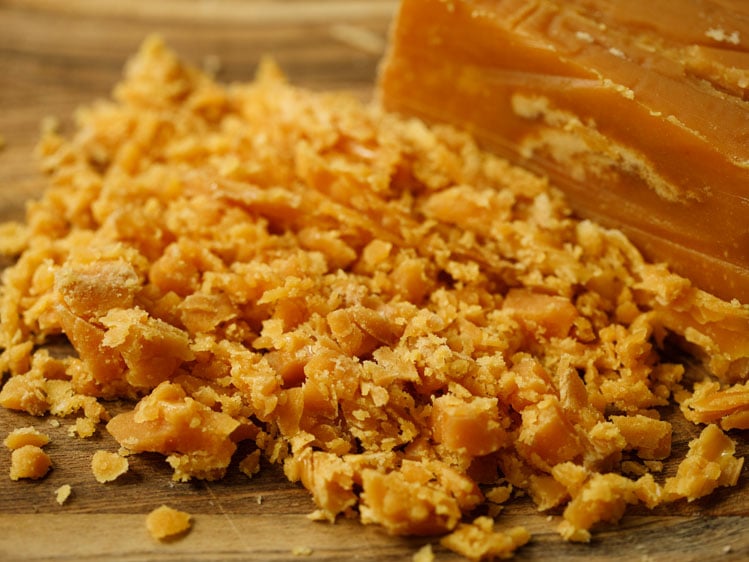
2. Heat ghee in a pan. Add ½ teaspoon poppy seeds. Keep heat to a low. Fry for some seconds till the poppy seeds start crackling.
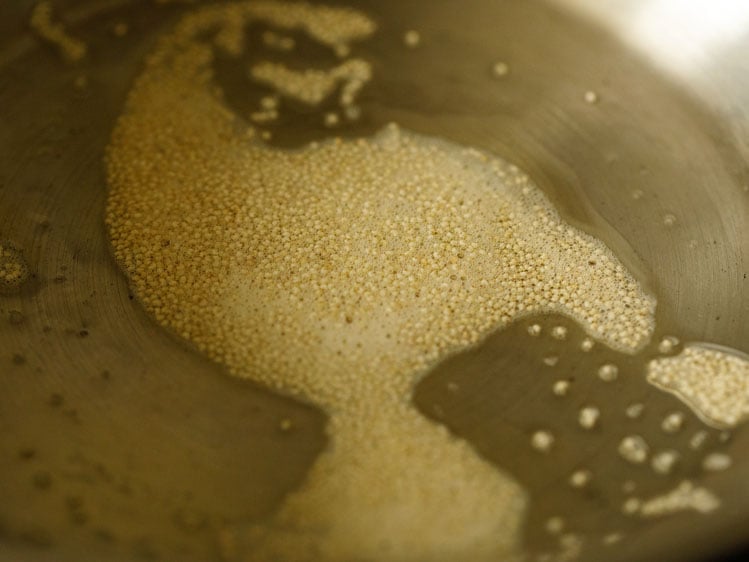
3. Then add 1 cup grated fresh coconut (100 grams) and 1 cup chopped jaggery (200 grams).
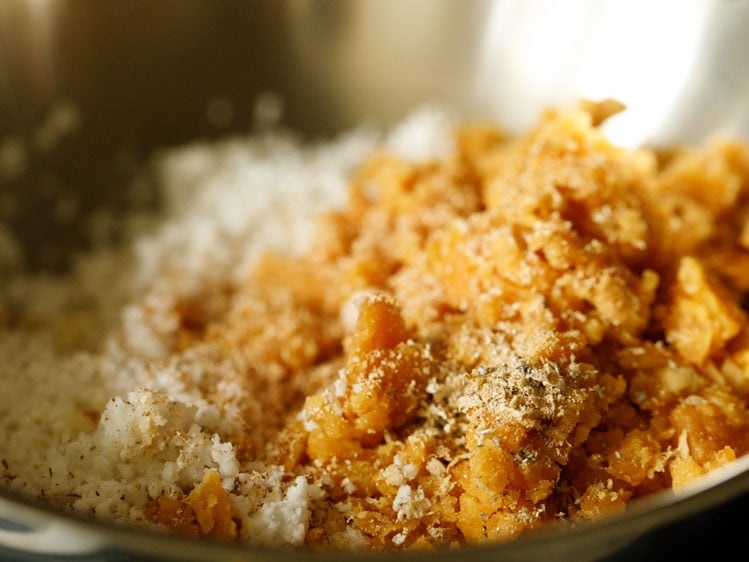
4. Mix well and cook this coconut-jaggery mixture on a low heat.
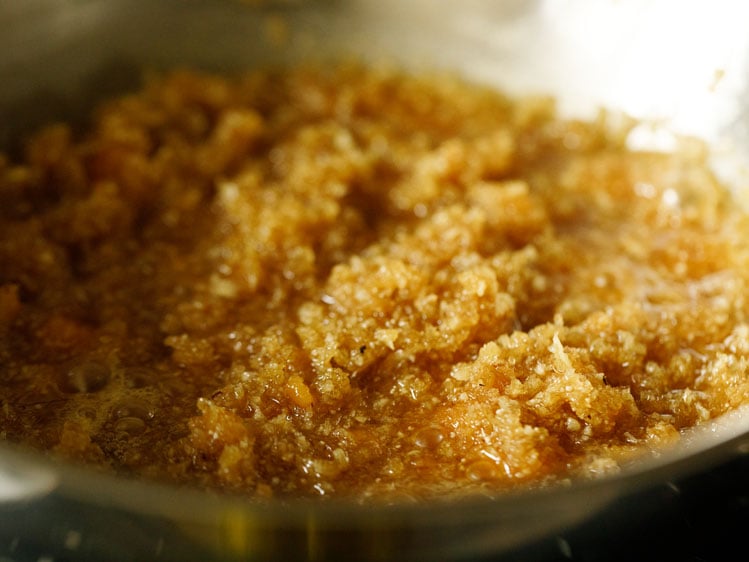
5. The jaggery will melt first. Cook on a low heat and stir often.
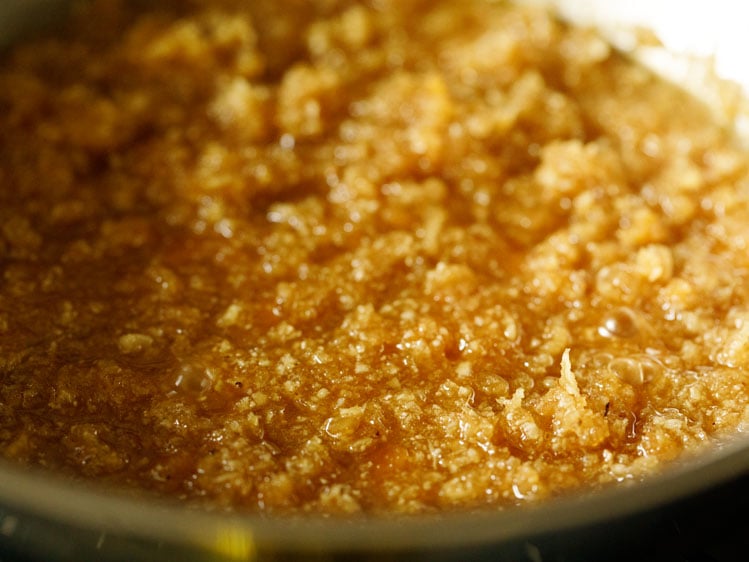
6. Stirring often cook this mixture till the moisture from the jaggery begins to dry – about 7 to 9 minutes. Switch off the heat.
Don’t overcook as the jaggery then hardens. Keep this coconut-jaggery filling aside and let it cool completely. On cooling, the mixture will thicken more.
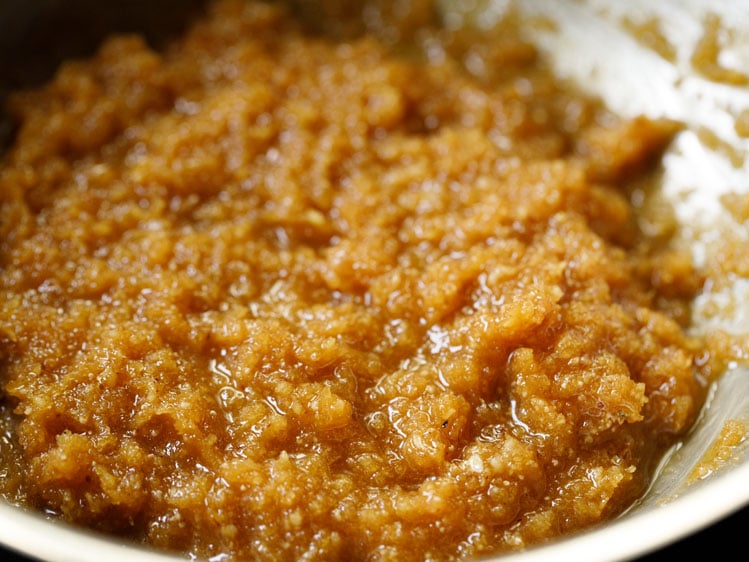
7. The following is an optional step. You can add 1 tablespoon rice flour to this mixture and mix well.
The rice flour helps to absorb moisture if any from the sweet stuffing. Set the stuffing aside to cool.
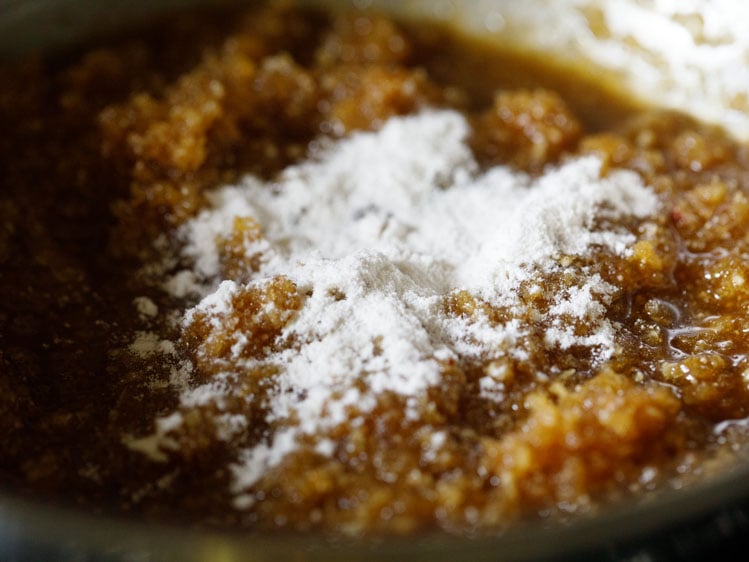
Make Rice Flour Dough
8. In a pan add 1.5 cups water, ¼ teaspoon oil or ghee and ¼ teaspoon salt. Keep it on the stovetop.
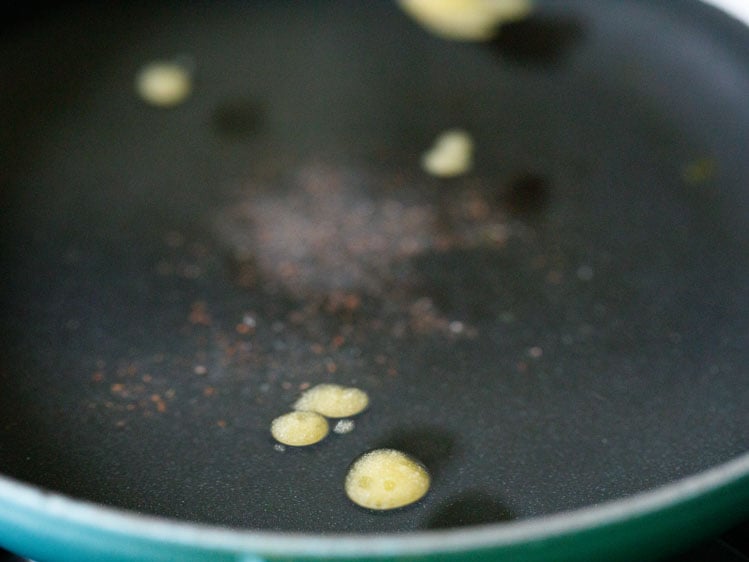
9. Let this mixture come to a boil.
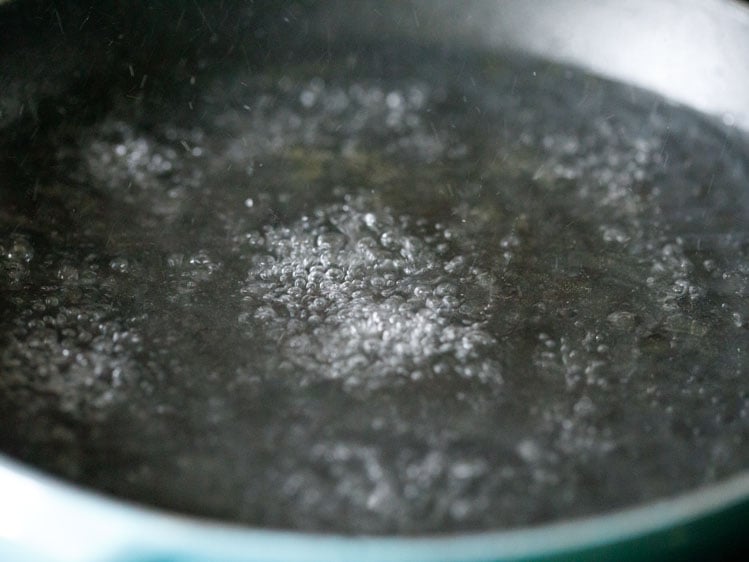
10. Add 1 cup rice flour (150 grams). You can use Homemade Rice Flour or packaged flour. Make sure the rice flour is fresh and within its shelf period.
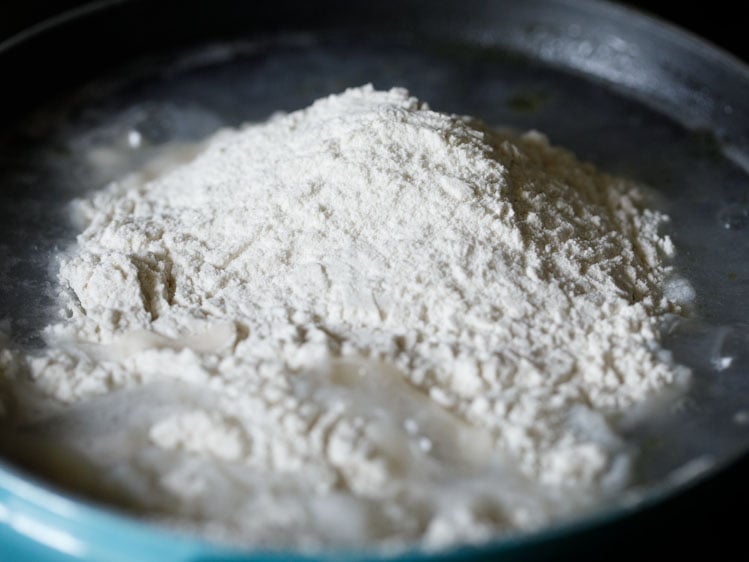
11. Quickly stir and mix the rice flour with the water.
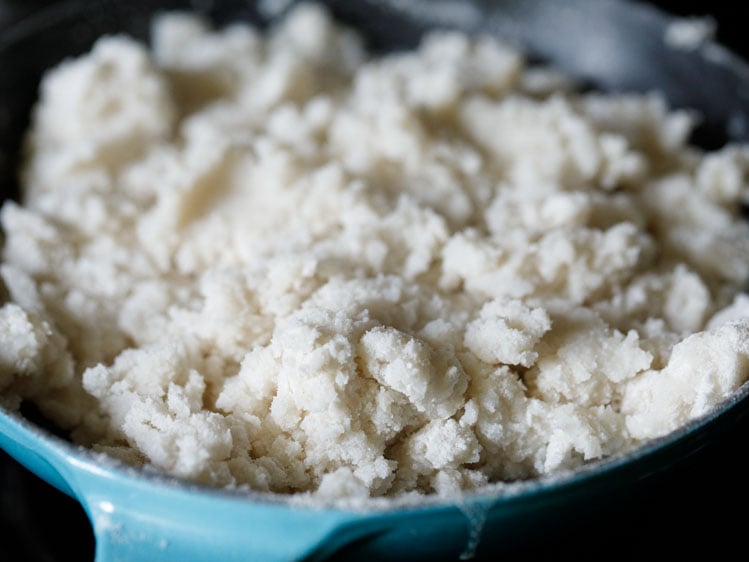
12. Stir till all the rice flour is mixed with the water. Switch off the heat. Remove the pan from the burner and keep on the workplace. Cover the pan with a lid for 4 to 5 minutes.
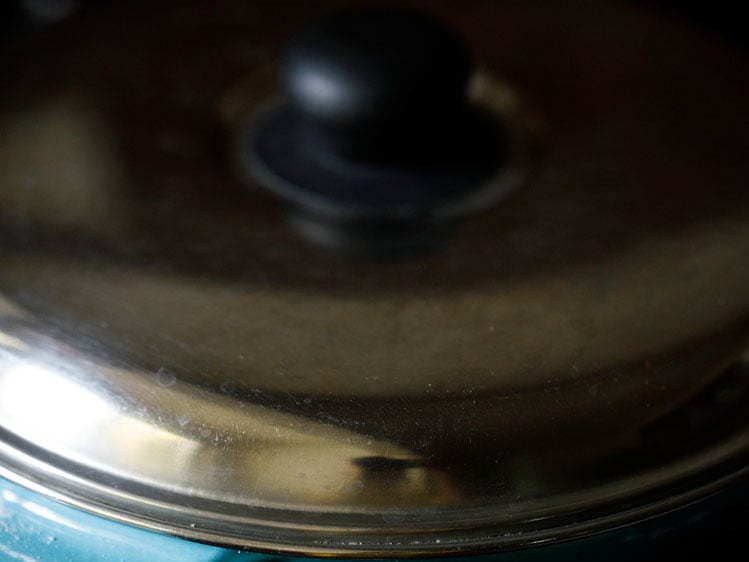
13. Now take all the dough in a plate or thali or in a bowl. Gather the dough together and begin to knead it.
The dough will be hot when you begin to knead. So spread some water on your palms and knead the dough. Knead the dough very well.
If you feel the dough looks dense or hard or dry, then just add a few teaspoons of warm water and continue to knead.
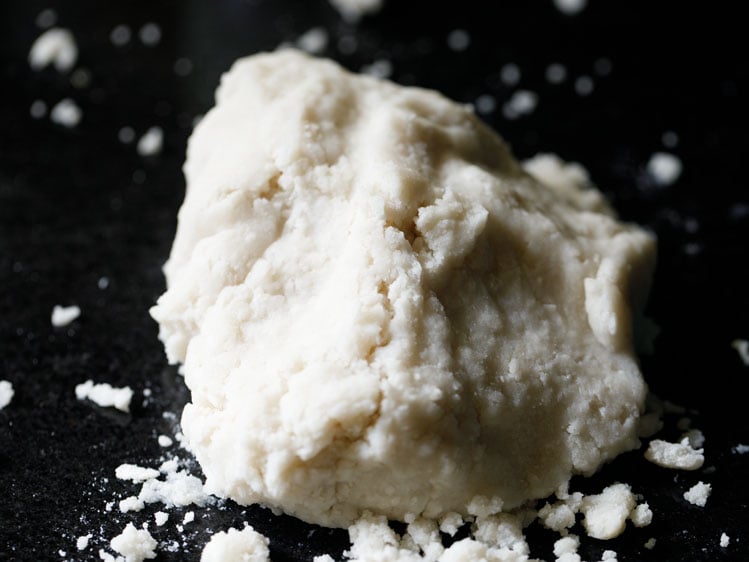
14. Knead to a smooth and soft dough without any lumps.
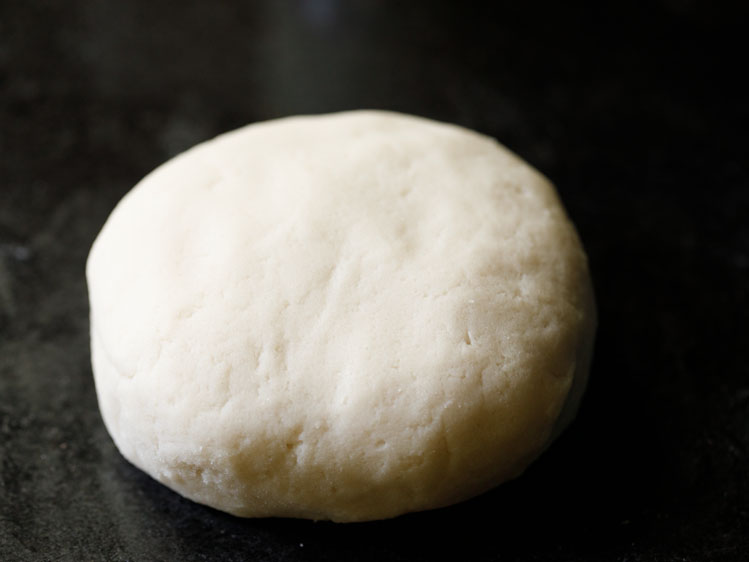
15. Make small balls from the dough. Roll the balls till smooth in your palms. You can also apply some water on your palms, while rolling the balls.
Keep the balls covered with a kitchen towel. The balls should not have cracks. They should be smooth in appearance.
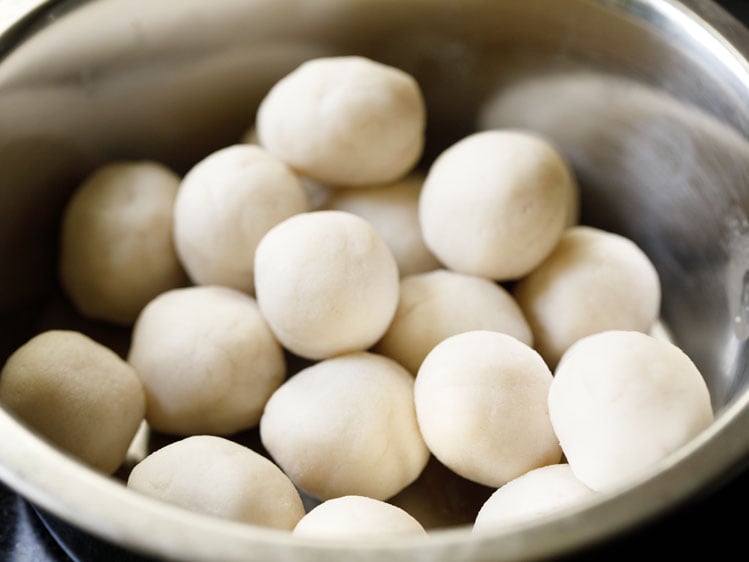
Shape Modak Without Mould
16. Take a ball and flatten it with your fingers or on your palms, to a round disc or a shallow bowl shape to a medium thickness.
You can apply ghee or oil in your palms, while flattening. You can keep the edges slightly thin and the center can be thick.
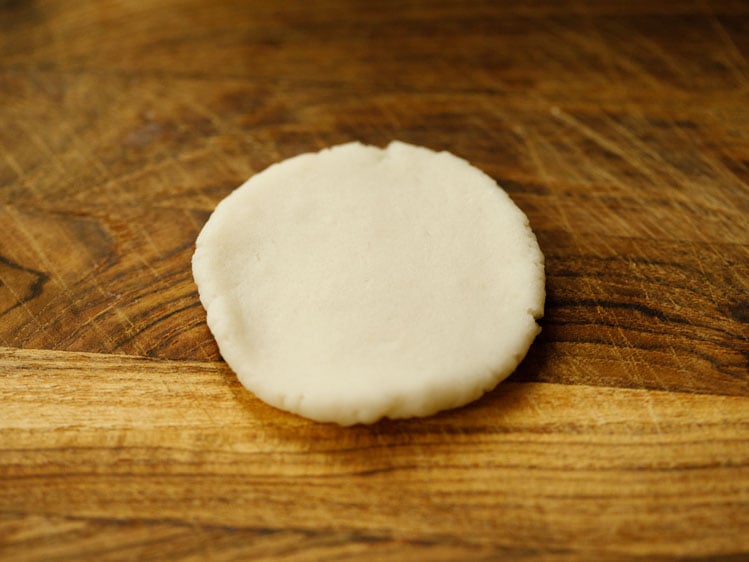
17. Place a few teaspoons of the prepared stuffing in the center.
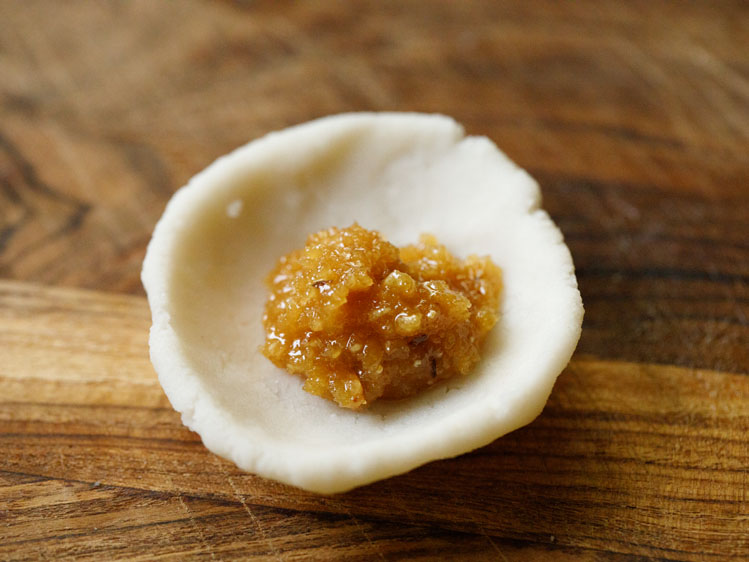
18. Press the edges as shown in the pic below. You can also press the edges first and then place the stuffing.
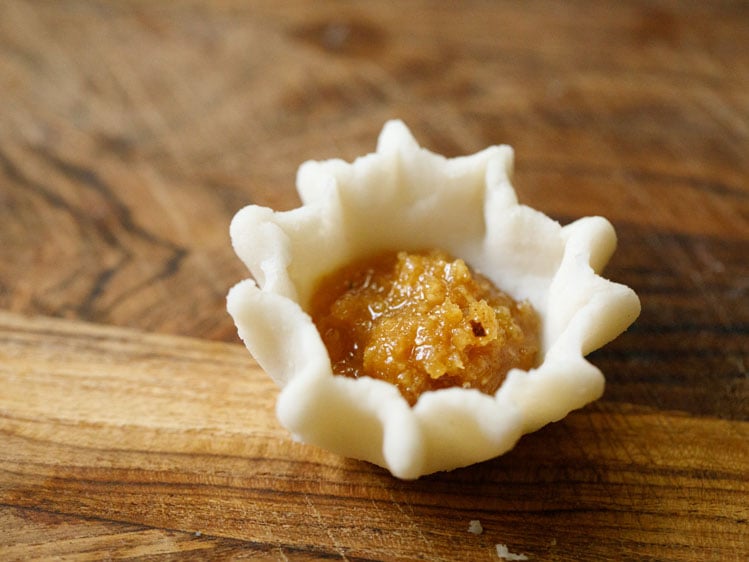
19. Bring together all the edges and join them. Remove the extra portion of the dough from the top, if any. Shape and taper the top of the modak with your fingers.
You can also use ready modak moulds. They are usually available in shops and market some days before the Ganesh Chaturthi festival.
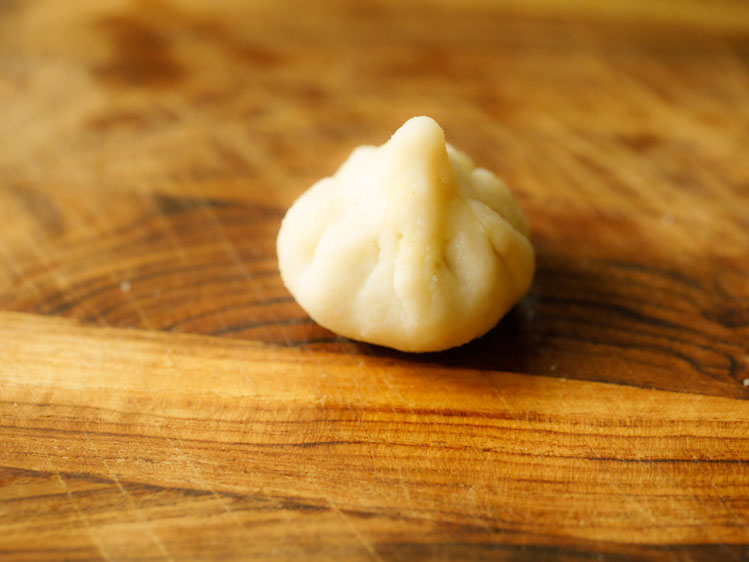
Shape Modak With Mould
20. Grease the modak mould with a bit of ghee or oil. Then close or lock the mould. Put the dough ball inside the mould and press it so that a space is made in the center. The rice dough will form a layer touching the walls of the mould.
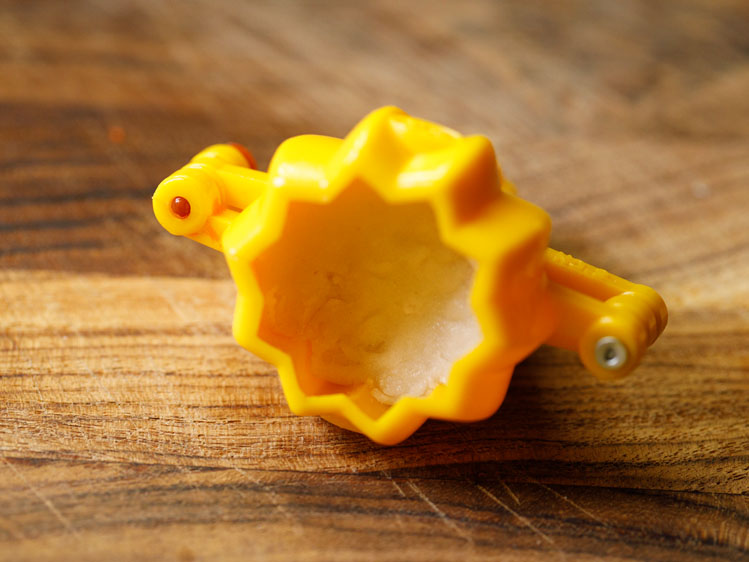
21. Place the sweet stuffing.
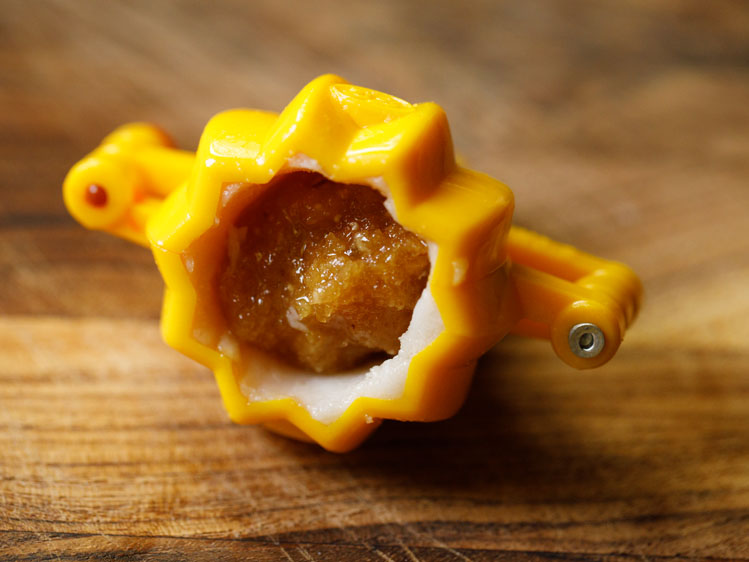
22. Cover the bottom with a small piece of dough. Press and smoothen it sealing the modak.
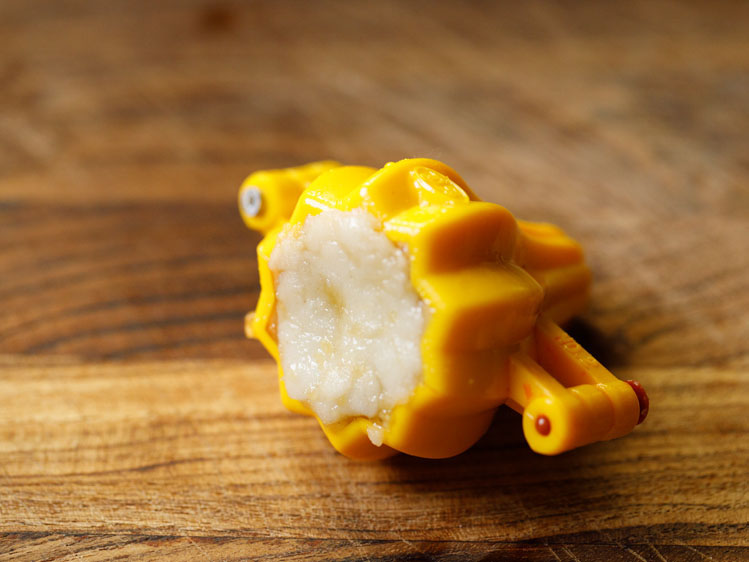
23. Open or unlock the modak mould. Remove the modak gently from the mould. Shape all modaks this way with mould.
Keep the shaped modak covered with a napkin so that the rice dough does not dry out.
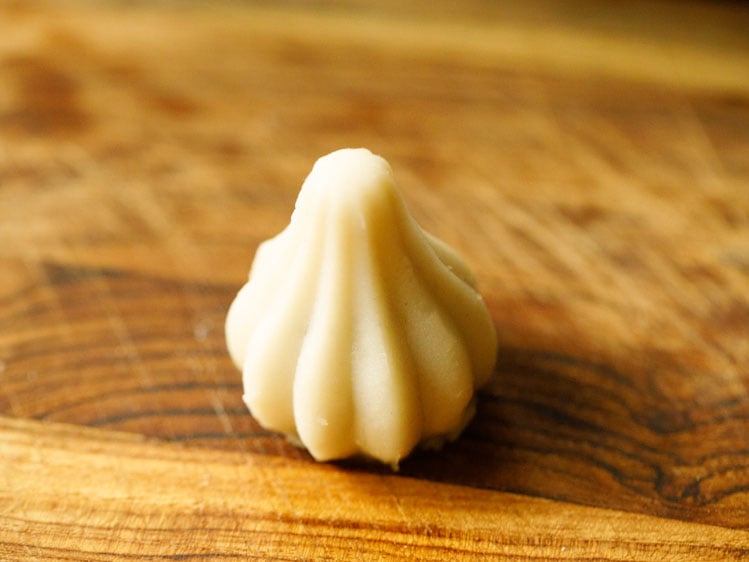
24. Make all the modak this way. Brush or grease a pan with some oil or ghee. The pan can also be lined with banana leaves or turmeric leaves.
Place the shaped modak in the greased pan with some space around them.
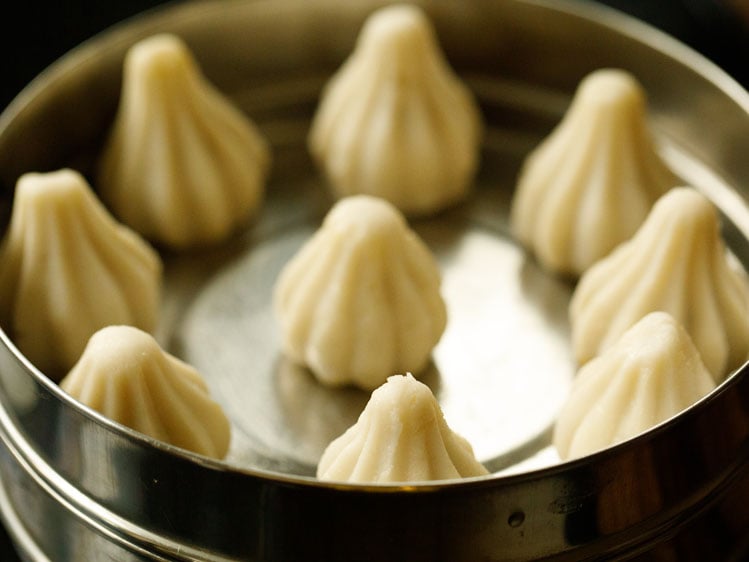
Steam Modak
25. Take 2 to 2.5 cups water in a pot, pressure cooker or an Instant Pot steel insert. Place a trivet or a rack. Heat the water till starts to boil on a high heat.
For instant pot, use the sauté option and let the water begin to boil.
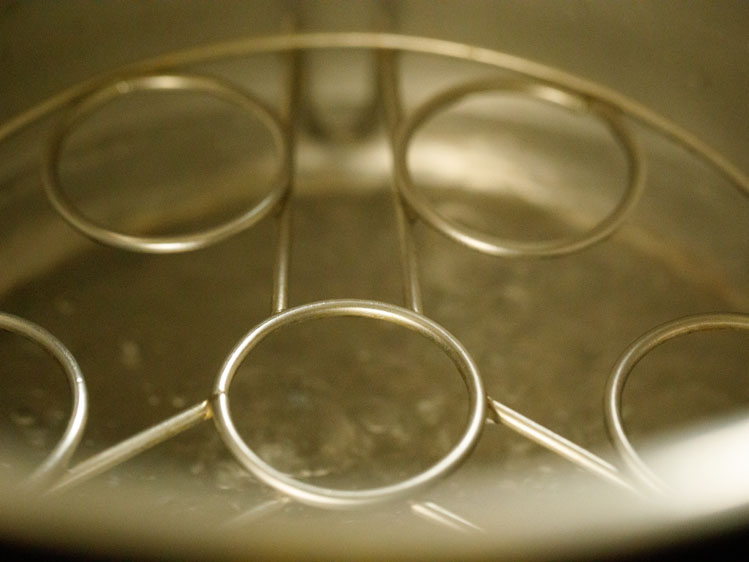
26. I have stacked two pans for steaming 16 modak. But you can also steam the modak in separate batches.
Remember to cover the shaped modak with a moist muslin or cotton napkin before you begin to steam.
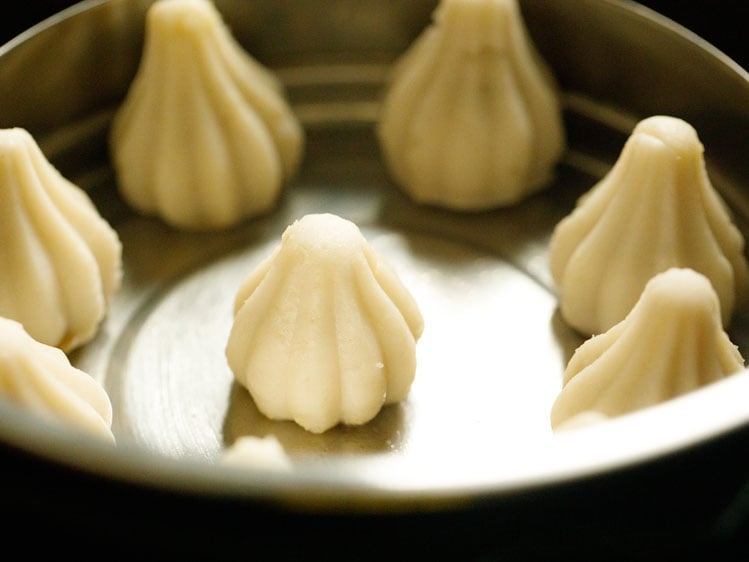
27. Cover the pan and steam modak for 10 to 15 minutes on medium-low heat. Once steamed, drizzle a few teaspoons on ghee on them if you prefer.
Some modak may crack while shaping or steaming, but it is fine. You can forgive yourself if you are making modak for the first time.
The modak should not feel sticky to touch when cooked perfectly. If they look or feel sticky, then steam them for a few minutes more.
On the Instant Pot, use the steam function on high pressure for steaming and keep the steam vent in venting position so that the steam releases while steaming.
Use a stop watch to set the time to 10 or 12 minutes. When the steaming is complete, lift the valve carefully to remove any pressure and then open the lid.
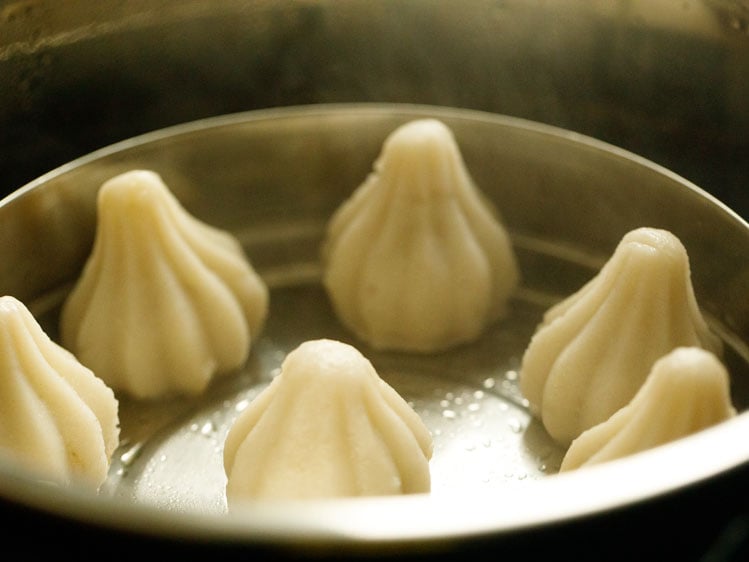
28. Ukadiche Modak is ready for offering Bhagwan Ganesha. Modak keeps well for a couple of days in the refrigerator.
While serving after refrigerating, steam them in a pan till warm or sprinkle some water on them and microwave till warm.
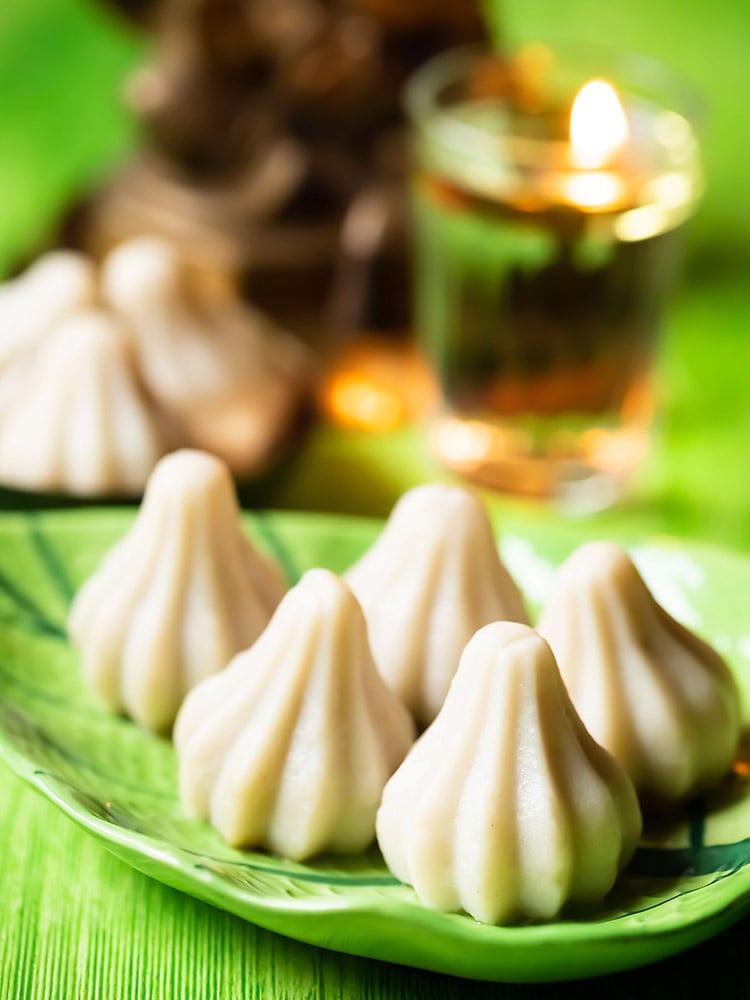
Important Note: If you are making the Modak recipe as prasad or naivedyam, then please refrain from tasting the stuffing or the dough.
Prepare with the utmost care, love and devotion and this prasad of modak will nourish everyone’s being subtly. Use clean utensils and good quality ingredients and prepare them in a clean and hygienic manner.
Expert Tips
- Rice dough: While making the Modak recipe, the most trickiest part for many is to get the correct texture in the rice dough. If the dough is dry, you will find it difficult to shape and the resulting texture after steaming will be chewy and dense. The proportion of rice flour to water I use work perfectly for a smooth and soft dough. However do note that depending on the texture of rice flour, you may need to add a bit less or more water.
- Stuffing: Overcooking the stuffing for this Modak recipe will result in the jaggery become hard and chewy. If this happens, then just sprinkle a few tablespoons of hot water in the mixture and stir well. The hot water will breakdown the hard consistency of the jaggery and make them soft. You can even sprinkle some water and cook the mixture on low heat until it softens.
- Cracks in the dough: Less water will result in the dough being dry and having cracks. If you add more oil or ghee than this will result in the dough tearing when you shape it.
- Flattening and Shaping: Do not flatten the dough too thin or too thick. A thin dough will tear while shaping and a thick dough will take more time to cook and does not taste pleasant.
FAQs
The Maharashtrian term ‘ukadiche’ means ‘steamed.’ Since these modaks are primarily prepared by steaming, hence, known as Ukadiche Modak.
Technically no, as both these are different and are unique in their own way. One most important factor that differentiates the two is that a modak will essentially have a sweet filling whereas a traditional momo has a savory or salty filling.
There certainly is. The Kozhukattai can pretty much be termed as the South Indian version of the Ukadiche Modak recipe.
If the jaggery mixture hardens, you can sprinkle some hot water in it and mix. This will loosen the hardness in the mixture.
If the outer dough becomes dry, then the modaks can crack open while steaming. Make sure that the modaks are not dry after being shaped and should always be covered with a clean kitchen towel. You must also keep the dough covered with a lid or a kitchen towel.
This can be due to less water in the rice dough. So, 2 to 3 teaspoons or more of warm water can be added to the dough and kneaded again till smooth.
If fine cracks appear while shaping, just dab your fingers with some water and shape. The cracks will fade away.
Also, make sure to knead the dough very well. While flattening the dough balls, you can sprinkle some drops of water on your palms or fingers and then flatten.
You can use watermelon seeds or sesame seeds. You can even make the modaks without any of these seeds.
Yes, you can prepare the modaks in advance and store. Keep them in a casserole or in an air-tight steel box. Make sure to cover the box tightly and then refrigerate. Like this, you can store the modaks for 2 to 3 days.
Yes, you can. But remember, the dry coconut/desiccated coconut-jaggery mixture will take less time to cook as compared to the fresh coconut-jaggery mixture. The taste will also be different in both.
More Modak Variants To Try!
Sweets Recipes
Sweets Recipes
Sweets Recipes
Sweets Recipes
Please be sure to rate the recipe in the recipe card or leave a comment below if you have made it. For more vegetarian inspirations, Sign Up for my emails or follow me on Instagram, Youtube, Facebook, Pinterest or Twitter.
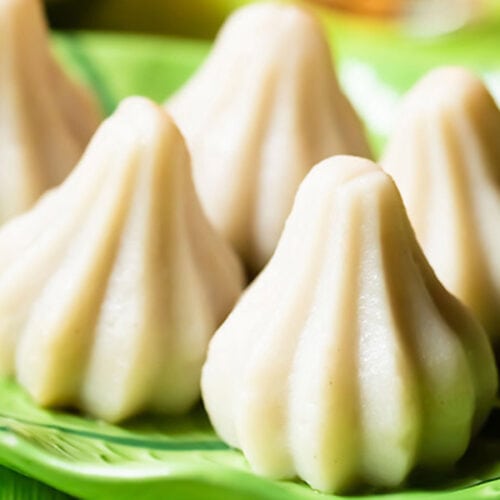
Modak Recipe (Ukadiche Modak) – With Mould & Without It
Ingredients
For the dough cover
- 1 cup Rice Flour – 150 grams
- 1.5 cups water
- ¼ teaspoon Ghee or oil
- ¼ teaspoon salt
For sweet stuffing
- 1 cup fresh grated coconut – 100 grams
- 1 cup finely chopped jaggery or grated or powdered jaggery – 200 grams
- 1 teaspoon cardamom powder or 6 to 7 green cardamoms, powdered in a mortar-pestle & husks removed
- ¼ teaspoon grated nutmeg or ground nutmeg powder (jaiphal powder), optional
- ½ teaspoon poppy seeds (khus khus), optional
- ½ teaspoon Ghee or oil
- 1 tablespoon Rice Flour – optional
Instructions
Making sweet stuffing
- Heat ghee in a pan. Keep heat to a low. Add poppy seeds. Fry for some seconds till the poppy seeds start crackling.
- Then add grated fresh coconut, jaggery, cardamom powder and grated nutmeg.
- Mix well and cook this coconut-jaggery mixture on a low heat. The jaggery will melt first.
- Stirring often cook this mixture for 7 to 9 minutes till the moisture from the jaggery begins to dry. Turn off the heat. Don’t overcook as the jaggery then hardens.
- Keep this coconut-jaggery filling aside to cool. Note that on cooling, this stuffing mixture will thicken more.
- You can also add a bit of rice flour to this mixture. This is an optional step. The rice flour helps to absorb moisture, if any from the filling.
Making rice flour dough
- In a pan add water, oil or ghee and salt. Keep it on the stove top. Let this mixture come to a boil.
- Reduce the heat and add the rice flour gradually. Quickly stir and mix the flour with the water. Stir till all the rice flour is mixed with the water.
- Switch off the heat. Remove the pan from the stove top and then cover this pan with a lid for 4 to 5 minutes.
- Now take all the dough in a large plate or thali or in a bowl. Gather the dough together and begin to knead it.
- The dough will be hot when, you begin to knead. So apply some water on your palms and knead the dough.
- Knead the dough very well. If you feel the dough looks dense or hard or dry, then just add a few teaspoons of warm water and continue to knead.
- Make small balls from the dough. Roll the balls till smooth in your palms. You can also apply some water on your palms, while rolling the balls.
- Keep the balls covered with a kitchen towel. The balls should be smooth in appearance and should not have any cracks.
Making modak without mould
- Take a ball and flatten it with your fingers to a round disc or a shallow bowl shape. You can apply ghee or oil in your palms while flattening. Place the sweet filling in the center.
- Flute and press the edges. Bring together all the edges and join them. Remove the extra portion of the dough from the top, if any. Shape and taper the top of the modak with your fingers.
Making modak with mould
- Grease the modak mould with a bit of ghee or oil. Then close or lock the mould.
- Put the dough ball inside the mould and press it so that a space is made. Place the sweet stuffing inside.
- Cover the bottom with a small piece of dough. Press and smoothen it sealing the modak.
- Open or unlock the modak mould. Remove the modak gently from the mould. Shape all modaks this way with mould.
- Keep the shaped modak covered with a napkin so that the rice dough does not dry out. Make all the modak this way.
Steaming modak
- Grease a steamer pan lightly with oil or ghee. Place the shaped modak in the greased pan with some space between them. Cover with a kitchen napkin.
- Take 2 to 2.5 cups water in a pot, pressure cooker or an Instant Pot steel insert. Place a trivet or a rack.
- Heat the water on high flame until begins to boil. For instant pot, use the sauté option and let the water begin to boil.
- The water should be hot or boiling when you place the modak in the large pan. Cover the pan and steam modak for 10 to 15 minutes on a medium-low heat.
- On the Instant Pot, use the steam function on high for steaming and keep the steam vent in venting position so that the steam releases while steaming. Use a stop watch to set the time to 10 or 12 minutes.
- Once the ukadiche modak are steamed, you can drizzle a few teaspoons of ghee on them.
- Note that after steaming, the modak should not feel sticky to touch. If the feel sticky, then steam for a few more minutes.
- Offer the Modak to Bhagwan Ganesha.
Notes
- Rice Flour: You can use homemade rice flour or packaged rice flour.
- Jaggery: You can use a block of jaggery or even powdered jaggery.
- Coconut: In place of fresh coconut, you can add frozen grated coconut or desiccated coconut. For desiccated coconut use fine grates or fine shreds.
- Poppy seeds: You can easily skip poppy seeds.
- Dough: Make sure that the dough does not become dry or sticky. If the dough is dry, then add some more water. If it is sticky add some more rice flour.
- Stuffing: Do not overcook the stuffing as this will harden the jaggery. If this happens, then just sprinkle a few tablespoons of hot water in the stuffing mixture and mix very well. The hot water will breakdown the hard consistency of the jaggery and make them soft. You can even sprinkle some water and cook the mixture on low heat until it softens.
- Cracks in the dough: Less water will result in the dough being dry and having cracks. Do not add more oil or ghee than what is mentioned in the recipe as this will result in the dough tearing when you shape it.
- Flattening and Shaping: Do not flatten the dough too thin or too thick. A thin dough will tear while shaping and a thick dough will take more time to cook and will taste doughy and unpleasant.
- Note that the approximate nutritional information is for 1 modak.
Nutrition Info (Approximate Values)
This Modak recipe post from the archives first published in September 2010 has been updated and republished on 25 August 2022.
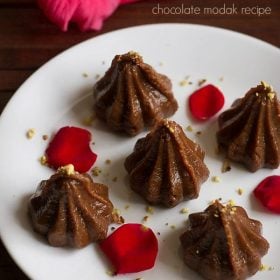
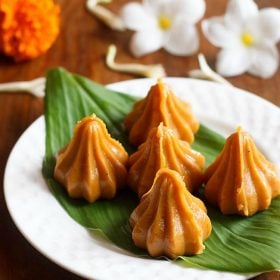
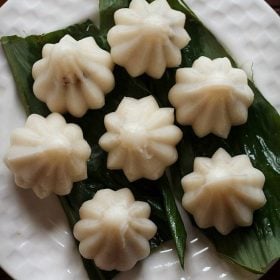
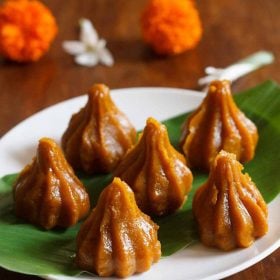
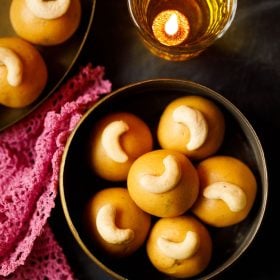
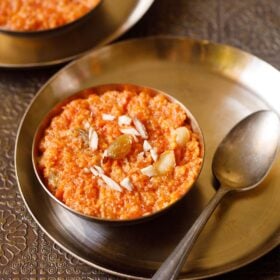
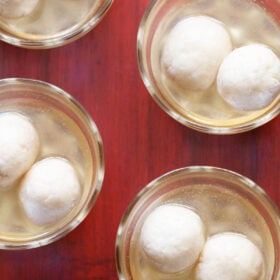
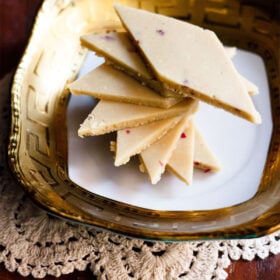








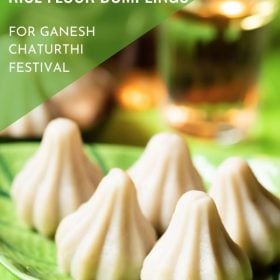
Hi Dassana
Can’t stop myself from expressing gratitude for this site
Everything is made with such love !!! Hope one day i can taste sweets you did yourself haha. LOVE
Thanks so much. Hope so!
Your knowledge of Tamil is amazing as always !!!
Thanks!
Hi! You are my go-to person (website :)) for any Veg recipe, and not once have i been disappointed. Tried the modak today for the first time.. except for the jaggery mixture hardening a bit- which i realised i overcooked, it turned out really really good! Thanks so so much!
Thank you Rasika for the feedback and glad to know that the modak was good. If the jaggery mixture hardens you can add sprinkle hot water in it and mix. It will make the jaggery loose the hardness.
Hi Dassana,
Thank you so much. All your recepies are very well explained. From past 7-8 years I have learnt & made so many recipies watching your videos. I learnt making sweets / desserts & my kids love them.
Thanks & lots of love & best wishes dear.
Meenakshi
Hi Meenakshi, thanks a lot for your lovely comment and kind wishes. Felt good to read and I am glad that the videos and the recipes are helpful. Most welcome and wish you all the best.
Never made modak must try it out
My modaks all cracked open while steaming. What could I have done wrong? Could you pls share a tip to prevent this from happening the other time
The modak should not dry out after being shaped and should always be covered with a kitchen towel. If the outer dough becomes dry, then they may crack while steaming. Even the dough should be covered with a lid or a kitchen napkin. I hope this helps.
Excellent way of explaining, specially the foot note. Thank you for not just sharing this wonderful and traditional receipe, but also for your gesture to protect the divinity and culture around making MODAK !
May Bappa always keep the Annapurna within you protected and blessed🙏😇🥰
Thank you so much. Touched by your comment and kind wishes. Wish you a Happy Ganesh Chaturthi festival full of peace, abundance and joy.
Your writeup are as lovely as the recipes. Your mentioning not to taste the filling is so apt.
May lord Ganesha bless you.
thank you priya for the kind wishes. wish you a happy ganesh chaturthi festival.
Hi Dassana.. thanks for this recipe and thanks for all ur recipes. I usually follow your site to make food. It has, to some extent, reduced my anxiety of making food every day, which was quite troublesome for me before. I simply love the way you describe the preparation method with the pictures, quantities (which we can adjust as per our needs), the do’s and don’ts. Thank you so much for making life easier. May Lord Ganesha bless you with happiness and joy. 🙂
hi pooja, thank you so much for this lovely feedback and also for your kind wishes. wish you a happy ganesh chaturthi festival and thanks again.
Hi dassana, we tried ukadiche modak but we were unable to shape them properly can you please give more comments on shaping them.
hi akash, it is due to less water in the rice dough. 2 to 3 teaspoons or more warm water can be added in the rice dough and kneaded again. if you see fine cracks while shaping, then just dap the fingers with some water and shape. the cracks will go away. also knead the dough very well. when flattening the dough balls, you can spread a few drops of water on the palms or fingers and then flatten. the shaping method shown here is the easiest. there is another way of shaping modak with many petals (pleats) and it comes only with practice. hope this helps.